Budapest to Amsterdam 2022
Western Danube River
The Danube is the second-longest river in Europe, after the Volga in Russia. It flows through or touches the borders of 10 countries, from the Black Forest into the Black Sea.
October 1
Bratislava, Slovakia
In the morning we woke up in the town of Bratislava, Slovakia. We were taken on a walking tour to Bratislava castle and town.


From the UFO Bridge, yep, that's what the locals call it, we go past the 13th century St Martin's Cathedral.










As you make your way up to the castle, you pass the Slovakian parliament building, a very modern looking structure.




Bratislava Castle, the landmark overlooking the Capital, was built in the 9th century. It proudly stands on the hill above Danube river. Eleven kings and eight queens have been crowned in this castle.





the gardens in the back of the castle are beautiful, and there is amazing views over the Danube and the city.










From the castle we all wander back down into the historic and quirky old town of Bratislava.




The name of the sculpture is Bosorka in Slovak, which means witch. According to the artist, the sculpture is supposed to be a monument to all the women who were accused of witchcraft and the repercussions of that in medieval times.




















One of the most beautiful buildings is the Slovak National Theater, the oldest professional theater in Slovakia, consisting of three ensembles: opera, ballet, and drama. It's history begins shortly after the establishment of the first Czechoslovak Republic in 1918, but it looks much older than that.







After touring the town we returned to the ship for lunch, and then for those of us that signed up, we were taken by bus for a Slovakian home visit in Šenkvice, a town of about 5000 people.


The group was split up and taken to different homes, our group was taken to visit Mr. Kamil and his wife Eva, and their 'failure to launch' son Kamil Jr.. They had a beautiful home that Mr. Kamil had completely built himself.




That's a home made BBQ
They had a very large backyard property that contained all kinds of fruit/vegetable/flower gardens, and that's what they wanted to show us first. We had a local translator with us, but when I trailed behind to take photos, Mrs Eva was showing me all her favourite plants very proudly. you don't need a translator to figure that out, and we had a choppy conversation of appreciation for her gardens.

















After telling us stories of building his house and gardens, having us sample the fruits, nuts and vegetables, we were invited inside for some cake. Eva gave us some extra cake to take to our bus driver too.




After we are finished our cake and tea/coffee, there is a couple pieces of cake left over, and Mrs Eva asks who would like some more, and I get the "Dave will", so being polite I ate the extra piece of cake. Mrs Eva was very happy with me.


Then Mr. Kamil opens a secret door that he had made, only to surprise us with his secret man cave/bar. The look of pride and joy on his face while standing behind that bar with a row of glasses could not be beat. Every one of us got a glass of their home made wine.




Mr. Kamil, Mrs Eva and our local translator discuss whether there is more wine in the cellar.


We are supposed to be leaving, but Kamil Jr is showing us all his pottery and artwork, and Mrs. Eva is showing off her preserves and bedroom art, which her husband painted for her.


It really was special to spend some time with the family, asking them all kinds of questions about their history and lifestyle, them telling us all kinds of stories, so when it was time to go, there was a few non-dry eyes getting back on the bus to the ship. After talking to some of the other passengers that went to other houses, their experience weren't all that great. We're lucky I guess.

Back on board, the ship leaves Bratislava and we enjoy the lights of the city while we enjoy our dinner.
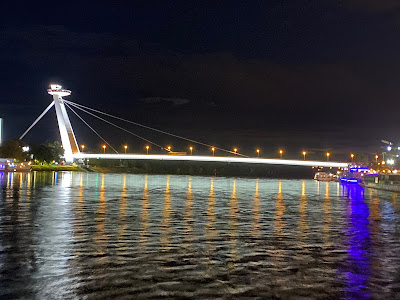



Each night we receive a menu that consists of an appetizer, a mid-course, a main course and a dessert. The main course was usually a local cuisine based fancy meat dish, a fish dish, or a vegetarian dish. There was also a selection of standard dishes including Salmon, Chicken breast, steak or Caesar salad if the nightly dishes didn't appeal. Each night there was a Chef's suggested meal and matching wines that you could opt for. Wines and Beers were always included with the meals.
After dinner it was Contest night in the lounge, it ended up with Dave (me) vs David (Montreal newlywed) in a game about identifying musicians and songs... we won and got a box of chocolates I shared with entire crowd in the lounge, even the losers.
October 2
Vienna, Austria



The morning view from our room was pretty cool, but it got better. While I was in the shower, I could hear Norine talking to someone. I came out to her having a chat with some local swans right outside our window.




We boarded the bus after breakfast, which would take us on a bit of a driving tour into Vienna. I had 2 problems with the driving tour; first if you were on the wrong side of the bus you really couldn't see much, and second, apparently we had the TB twins right behind us hacking their lungs out. Even though Norine and I were wearing masks, I'd be surprised if we didn't get sick.






Vienna has a long storied history in Europe, and after finally being let of the bus we got to walk amongst that history (for Norine and I, it was our second time there). The Austrian National Library (Österreichische Nationalbibliothek) is an impressive building, but the walking tour didn't take us in there.











The Hofburg is the former imperial palace of the Habsburg dynasty. It was built in the 13th century and expanded several times afterwards. It also served as the imperial winter residence, and Schönbrunn Palace was the summer residence. Since 1946 it is the official residence and workplace of the president of Austria.









The Spanish Riding School is located in the Hofburg Palace in central Vienna, one of the best Viennese palaces to visit. Built in the 13th century, it’s where the Habsburg royals ruled for several centuries. So why is this very Austrian institution called the “Spanish” Riding School? It’s named after the Spanish horses imported by the Habsburgs in the 16th century, which led to the famous Lipizzaner breed. They were considered a symbol of the country’s military strength because the Austrian soldiers on horseback could outmaneuver their opponents. The school is still a pretty traditional place. In fact, it just admitted its first female rider in 2016.






From the stables we are back into the streets of Vienna quickly as they right next door to the old city streets.








The Plague Column (Wiener Pestsäule) was erected after the Great Plague epidemic in 1679.





St. Stephen's Cathedral first building was finished in 1160, but burned down in 1258. The church was reconstructed using two surviving towers and was once again consecrated in 1263. Since then, St Stephen’s Cathedral has continued to gradually grow and reshape over time, with large sections rebuilt after damage caused during WWII.







Once we entered the church the walking tour was over, and we had the rest of the afternoon as free time before we had to go back to the ship.










I had a long conversation withe our Ships Hotel Manager Wolf the night before as he was from Vienna. His first recommendation was to have lunch at Plachuttas Guesthaus zur Oper for the real Wiener Schnitzel. It was delicious and inexpensive... apparently Vermont John had to big of a breakfast to order some, he doesn't know what he missed. I was also very pleased to get a nice Peach Iced Tea that had been sadly lacking for the previous weeks of adventures.



One of the drawbacks of having a half full ship is that some of the special excursions were being cancelled because they didn't have enough people signed up. Afie had signed up to go see Schönbrunn Palace, and was very disappointed that she couldn't see it. Little did she know, I had gone to Wolf and determined how we could travel there on our own.
We walked through town to the opera house, and caught a taxi to Schönbrunn palace with John and Jane from Vermont.

At the end of the seventeenth century Emperor Leopold I commissioned an imperial hunting lodge for his son, Crown Prince Joseph. In 1728 Emperor Charles VI acquired Schönbrunn, but used the estate only for shooting pheasants. Eventually he made a gift of it to his daughter, Maria Theresa, who always had a special fondness for the palace and its gardens. Under her personal influence, Joseph I’s grand hunting lodge was rebuilt and extended into a palatial summer residence. Schönbrunn Palace is now on the list of UNESCO World Cultural Heritage Sites.


Withe it being a weekend, the palace was extremely busy, and we had a 2 hour wait before being allowed inside of the palace. That actually works out well, because the huge garden areas surrounding the palace would easily take a couple hours.


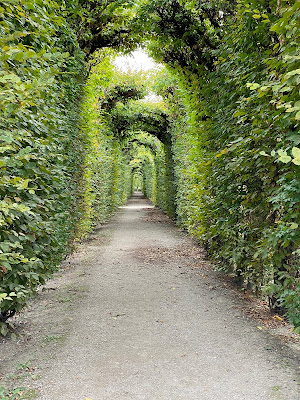
The last project initiated by the empress during the 1770s was the designing and laying out of the gardens. She had architectural features in the park such as the Gloriette, the Neptune Fountain, the Roman Ruin and the Obelisk Fountain created. In addition the avenues, fountains and open spaces were enhanced with statues and sculptures in the antique style. The remodelling of the palace and gardens was not finally completed until just before Maria Theresa’s death in 1780.






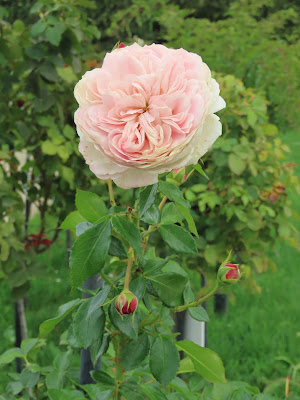




The Neptune Fountain at the foot of the Gloriette hill was designed to be the crowning monument of the gardens. Commissioned by Empress Maria Theresa, work on the fountain began in 1776 and was completed within four years, just prior to the death of the empress.It contains the sea-god Neptune and his entourage.


Norine, John, Jane and I left Afie behind at the fountain and hiked up to the Gloriette.






The views from Gloriette over the grounds and city beyond are a-maz-ing.




The Roman Ruin is actually a fake Roman Ruin, based on the Ancient Roman temple of Vespasian and Titus.




other pics




It was finally our entry time for the Schönbrunn palace, so we all headed to the entrance, collected our voice-boxes which you hold up to your ear, and listen as it gives details of each of the 40 rooms when you enter them.













After a very nice day exploring Vienna and the palace, we returned to the ship just in time for dinner. We were greeted by a couple swans that wanted to make sure we had a good day.


Tonight we are going to a private Viennese concert at Lobkowitz Palace. The Palace ranks among the oldest palace buildings of Vienna. In 1804, Beethoven's Third Symphony was performed for the first time in Vienna in this hall, with the composer as conductor.






It was such a moving concert, with the music of Strauss, List, Proust, Mozart and more. You don't realize how much classical music you actually know until you see a concert like this.




Part of the show was a mix of songs featuring Opera singers, first a female singer, then
a male singer.Then a funny moment when there seems to be a scuffle, she starts yelling at
him... "I can't believe you were kissing my sister", and Norine exclaims loudly "NO!".
They then break into an opera piece that is about jilted lovers making up.


Norine's exclamation was not the funniest moment of the night for me, it was standy guy. One of our passengers was a typical annoying tourist, standing right near the side of the stage filming big chunks of the show with his phone. I had to crop him out of my photos. When the male opera singer came out for their duet, standy guy was right in the way, so he starts singing at full operatic volume right in the guys ear, then says "excuse me" to get past him. I was dying trying not to laugh out loud.


Impressive night statue on our way back It's hard to see the custom "Fuck War' art here
It's hard to see the custom "Fuck War' art here
We spent the evening in the lounge with Wolf listening to his amazing stories of past jobs and clients that he has had. We were about to call it a night, but we entered a lock, so we watched as the ship went through the lock, one of 68 on this trip.





October 3
Dürnstein, Austria
We woke up in Dürnstein , and after a quick breakfast we had free time to explore the town. Dürnstein is well-known for its wineries and is one of the most popular tourist destinations in the Wachau region. The city's name literally means “dry castle” in German, presumably after the stone castle situated high above the main town area.














We wandered through the shops, found some hand-painted souvenirs for our infamous travel tree, and also picked up some small bottles of the different Apricot brandies from the area.







This history of Dürnstein Abbey begins in 1372 with the consecration of a Mary Chapel. In 1410, Augustinian Canons were brought to Dürnstein from Wittingau in Bohemia and the expanded building complex was established as a monastery. Over the course of the fifteenth century, the canons constructed the church, priory and cloister.


















Having fully explored the little town, we got back on the boat and sailed away withe even better views of the town.




From Dürnstein we made our way along the Wachau valley.














The Hinterhaus (Spitz Castle) is a ruin perched atop a hill overlooking Spitz and the Danube. The ruins of the Hinterhaus Castle originate from the 12th century. The castle dates back to the time of Kuenringers rule when it served as a strategic stronghold. From here they were able to rule the entire Wachau valley.








The Kuenring family is believed to have started construction of Aggstein Castle on the hill high above the Danube in the early 12th century. It's hard to see the extent of the castle fortifications from the river.


Schloss Schönbühel castle was begun in the early 12th century by Marchwardus de Schoenbuchele as a defensive fortress.


Melk, Austria
After lunch we arrived in Melk, It’s known for the 11th-century Melk Abbey, a vast monastery built high above the town.




We are split up into a few groups and walk through the town and up to Sift Melk.













Melk Abbey (Stift Melk) is a Benedictine abbey above the town of Melk, on a rocky outcrop overlooking the Danube river. The abbey was founded in 1089 when Leopold II, Margrave of Austria gave one of his castles to Benedictine monks from Lambach Abbey. Today's Baroque abbey was built between 1702 and 1736. Particularly noteworthy are the abbey church with frescoes and the library with countless medieval manuscripts.

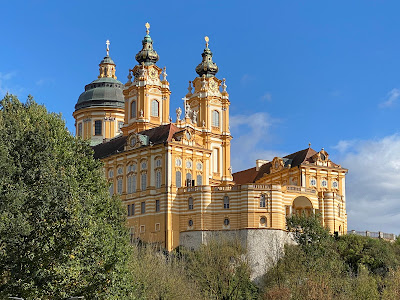


You enter through the Abbey Portal, we are let in one group at a time, and then once indoors, you aren't allowed to take photos. They try to tell you it's to protect the historical paintings, relics and structures, I think it's to sell more postcards and books.
















You are allowed to take photos when you are out on balconies, including the Altane
balcony which leads to the library.
The views from up here are a-maz-ing.










As soon as we enter the cathedral portion of the Abbey, it is free time. After a quick stop in the gift shop for some postcards, we headed to the gardens. From the front of the abbey, you access the Gardens and Barocker Gartenpavillon. After the completion of the abbey buildings the gardens and the pavilion was erected in 1747 and 1748 for the recreation of the monks after strict fasting periods.






It's all downhill from here, back into town.




One of the things I really grew to appreciate on this trip was the unique store signs hanging above doorways.








Apparently this cat is famous in this town, and she is very friendly.











As the sun is coming down, we are back on the ship for dinner.
Finally got in touch with our Credit Union cause we couldn't log in without an active cell phone. So we can't pay bills, including our stupid travel CC which has over $4000 in holds from our car rental which ended a week ago.

One more of the many locks we would travel through
The evening ended with some charades and dancing. Our side of the room won handily, Harry didn't even read the final score. Norine and Jane were on fire, but the Aussies were experts on our team. They won a bottle of apricot brandy which they shared shots of with everyone... it wasn't great.
October 4
We woke up to a foggy morning and we were still cruising down the Danube.








Yep, more locks


We cruise past farms and small villages, even giant fields full of pumpkins.







As we get close to Passau, we have now crossed the border into Germany, nobody checked my passport. You can certainly spot the city as we start approaching Passau, the town on one side, the castle on the other.





Passau, Germany
We finally docked in Passau, Germany at noon. Norine, Afie and I snuck off the ship early before the walking tour started and wandered the town by ourselves.An opportunity to check out shops and old buildings without a crowd, and a need to keep up.








Throughout the old town, a rainbow of cobblestones leads you to popular shops and destinations.




Did I mention my fondness for signs? Well, Passau had a few.


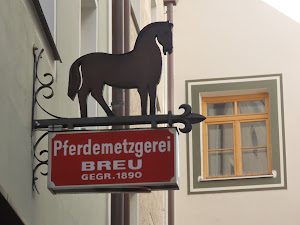










It's hard to see in the picture, but as we are standing by some flowers a hummingbird hawk-moth is flitting all around us.










The parish church of St. Paul dates back to 1050, making it the oldest parish church in Passau. After being destroyed by fire in 1512 and 1662, the present building was built in 1678.






After walking so much, we needed a break and found a cute little cafe for some strudel. Damn good strudel!



St Stephan's Cathedral was built from 1668 to 1693 after a fire in 1662 destroyed its predecessor. Passau Cathedral's used to be the largest organ in the world. It still is the largest church organ outside the USA, with 17,774 pipes and 233 registers.














St Michael's Church was constructed between 1665 and 1678 , today the seminary buildings hold the Passau State Library. It includes 360,000 books, including over five hundred printed before 1501. There are 320 manuscripts, some of which are from the 13th century and are apparently beautifully illustrated.They didn't let us peruse the books.
















I bought a unique German shirt, this will be my fancy dress shirt for the rest of the trip.


Having seen 3 churches and most of the town, we dropped Afie back at the ship and crossed the bridge to climb 300 stairs up to the fortress at the top of the hill (Veste Oberhaus).







3rd place photo in the ships photo contest
Veste Oberhaus is a fortress that was founded in 1219 and, for most of its time, served as the stronghold of the Bishop of Passau. It is currently the site of a museum, a youth hostel, and a restaurant, as well as an open-air theater dating to 1934.





We caught up with Harry's small hiking group and joined them to go to the overlook.



Our ship at Ort-spitze  Rathaus Passau (Townhall)
Rathaus Passau (Townhall)


St. Michael's Church  St. Stephan's Cathedral
St. Stephan's Cathedral
After spending some time enjoying the view, we all headed back down through a nice forested trail.




We walked past the boat, and had a little quiet time at Ort-spitze, the "Three Rivers Corner". The place where the three rivers (Danube, Ilz and Inn) merge, is a little park with a walking trail and benches..






Schaibling Tower was once used for defense & storage, this restored 13th-century riverside tower hosts occasional events.


Well rested after our day of wandering and hiking, we got back on the boat before it sets sail for our next stop.




Now that we are in Germany, at dinner I switched from the ship brew Carlsberg of Denmark, to Budweiser of the Czech Republic. I can't even begin to explain how much better this beer is than the American slightly more alcoholic than water Budweiser.

Once again it was contest night in the lounge... night of the stars, and we kind of won again... apparently we watch a lot of movies. The tie-breaker was famous lines from movies, we kind of kicked butt, 8-2, and won a box of Mozart chocolates, the rest of our team is making me take it home. May as well stay up and shut down the bar again, the bar staff are getting to know us very well.
October 5
Before we left on our trip, there was concerns with water levels. Due to a long drought in Europe, the levels were super low a month ago and ships couldn't travel certain areas of the river. After a couple days of rain in Germany, now the water levels have risen and we barely fit under some bridges. The captain would put a water bottle at the front of the ship to ensure we fit. If the bridge touched the bottle we had to stop and back up... it just cleared the bridges.




Regensburg, Germany
Due to the number of locks and high water levels, we were expected to arrive at our next stop around noon, but our captain must have timed his speed so we arrived at locks early. We arrived in Regensburg 3 hours early, so Norine, Afie and I charged off after breakfast and zig-zagged all over the old town. Looking in shops, looking in windows, you never know what you will see.











Basilica of the Nativity of Our Lady is the oldest Catholic place of worship in Bavaria and one of the most important churches in the city of Regensburg. The collegiate church and smaller basilica is part of an old abbey dedicated to the Virgin Mary founded by the emperor Henry II, ruler of the Holy Roman Empire in 1002.







Signs, signs, everywhere there's signs












The Neupfarrkirche is a Protestant parish church on Neupfarrplatz in the old town of Regensburg. Originally planned as a Catholic pilgrimage church, construction began after the destruction of the Jewish Quarter in 1519. In 1542, the city of Regensburg wanted to use the church as a new Protestant church after the introduction of the Reformation.


















Altes Rathaus, the Old Town Hall was built in the middle of the 13th century in the style of the patrician house castles. The tower burned down in 1360, but was restored by 1363.












Theater Regensburg (also known as the Stadttheater Regensburg) is a theatrical organization that produces operas, musicals, ballets, plays, and concerts. After it burned down the theater was rebuilt under a new design, and opened in 1852.







The Stone Bridge (Steinerne Brücke) is a 12th-century bridge across the Danube linking the Old Town with Stadtamhof. For more than 800 years, until the 1930s, it was the city's only bridge across the river. It is a masterwork of medieval construction.









At the highest point of the bridge is a stone carving called the Bruckmandl or Brückenmännchen (bridge mannikin), a largely naked man shielding his eyes with one hand and with an inscription reading "Schuck wie heiß". It's supposed to represent the lookout for the city, but we had so many less mature thoughts on what was going on.


We crossed the old Stone bridge to Stadtamhof on the opposite side of the river. Once a separate medieval village, the tiny island of Stadtamhof is full of historic remains, including the rococo church and monastery complex of St. Mang as well as shops the locals go to.

















One of the highlights of the area was the block long farmers market, we finally got to see where the locals actually do their shopping.











Eventually we made our way back across the bridge and into the old town.







Regensburg Cathedral, also known as St. Peter's Cathedral, is an example of important Gothic architecture within the German state of Bavaria. When the previous cathedral burned down the architect that took over supervision over the new cathedral in 1280 was trained in France, and because of this there was an incorporation of French Gothic architectural themes.
















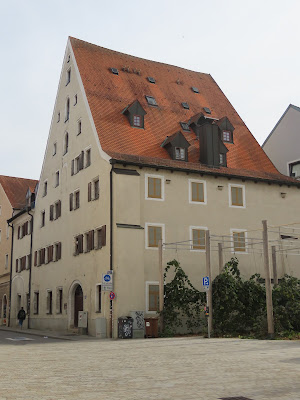




There's nothing quite like sitting in a historical square and eating the local delicacy with a local beer. In Regensburg that delicacy is Currywurst and the local beer is Kneitinger.





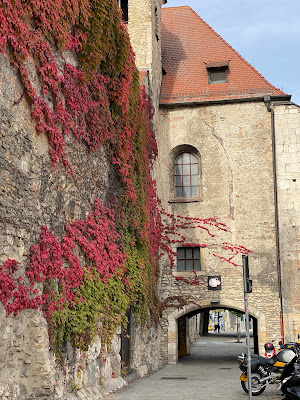


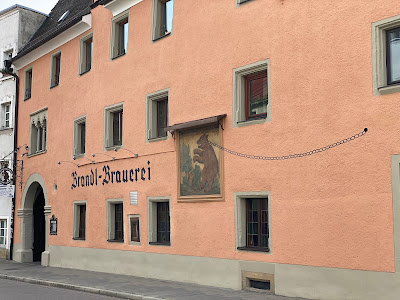
The Ostentor , which was built in 1284 on the eastern edge of today's old town, was one of six gate towers of the former city fortifications and was built to protect the then so-called "Ostenvorstadt".




Almost back at the ship is the Royal Villa, built from 1854 to 1856, it was the summer residence for Bavarian king Maximilian II.


From here we left Afie at the ship and made the bad decision to walk to the Thurn & Taxis palace... a waste of time. We took the long way around to get there by accident, and most everything was closed up already.







The 'Schloss Thurn und Taxis' is said to have more rooms than Buckingham Palace, and the rooms are stuffed with antiques and gilded knick-knacks--even after the family auctioned off treasures worth €27 million to pay debts and tax bills. The founder of the dynasty made his fortune with Europe's first postal monopoly. Too bad we couldn't go in and see it.












The art of Regensburg is quite varied, historical old buildings, statues, store signs, cute artwork, and a big shiny golden turd.




I think we covered as much of Regensburg as we could and went back to the ship just before it left.

Norine and a bunch of the gang decided to hang out in the infinity pool while the ship continued the next part of it's journey.




As we head through another lock, I ran to the front to watch the process, and they all stayed in the pool.





After another Bavarian dinner, tonight's entertainment was a Bavarian Brass Band. They jumped on the boat at the Kellheim lock. Then after they were done, they jumped off at the next lock. They were a lot of fun, and covered a lot of Bavarian historic songs, especially the ones made famous during Oktoberfest events around the world. At one point they made me the chancellor of Bavaria, and I had to conduct the orchestra.



The bands departure also indicated our departure from the Danube River, and on towards the Main River via the RMD Canal.


